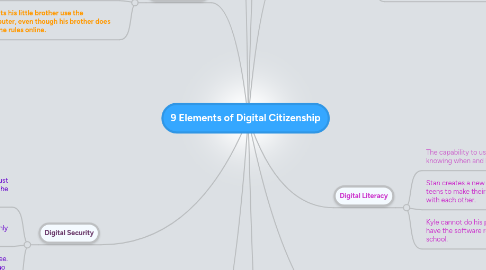9 Elements of Digital Citizenship
by Marvin M

1. Digital Security
1.1. The precautions that all technology users must take to guarantee their personal safety and the security of their network.
1.2. Mary sets her profile so that only her friends can see. She doesn't post her address and only adds people she knows.
1.3. Jerome sets his profile so everyone can see. He posts his address and adds anyone who will send a friend request. He will open any email sent to him.
2. Digital Communication
2.1. The electronic exchange of information
2.2. Steve did not text his friend back during class, but instead waited until after class.
2.3. Bob has his phone on high during class, and his friend texts him.
3. Digital Etiquette
3.1. The standards of conduct expected by other digital technology users.
3.2. Josh walks out of the library to talk to his mom instead of talking inside the library.
3.3. Bill lets his little brother use the computer, even though his brother does not the rules online.
4. Digital Health and Wellness.
4.1. The elements of physical and psychological well-being related to digital technology use.
4.2. Sally goes home, does her homework, excercises with friends and eats before she sits down to use her computer. She sits straight and does not slouch.
4.3. Token goes home and spends all his time on the computer. He does not take any breaks except to eat. He slouches in his chair and does not sit up straight.
5. Digital Rights and Responsibilities
5.1. the privileges and freedoms extended to all digital technology users, and behavioral expectations that come with them.
5.2. Ken does not use images he does not know the source of.
5.3. Tyrone does a general image search, saves pictures and does not site the real website. He only cites the search engine.
6. Digital Access
6.1. Full electronic participation in society.
6.2. Joe is able to do his school work on the computers provided by his school
6.3. Cole's school does not have student computers and he does not have the software at home to do his project on.
7. Digital Law
7.1. The legal rights and restrictions governing technology use
7.2. Penny buys CDs from stores and buys music from the internet. She doesn't give copies of her music to friends for free.
7.3. Kenny downloads music illegally and pirates softwares. He shares this with friends.
8. Digital commerce
8.1. The buying and selling of goods online.
8.2. John spends time researching the best and reliable site to buy electronics. He makes sure it is secure when he provides his credit card info.
8.3. Clyde buys a TV from the first search result without seeing if the website is reliable, and uses his credit card.
9. Digital Literacy
9.1. The capability to use digital technology and knowing when and how to use it.
9.2. Stan creates a new website that allows teens to make their own music and share with each other.
9.3. Kyle cannot do his project because he doesn't have the software required that they do have at school.


